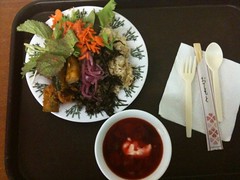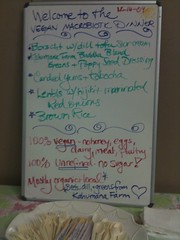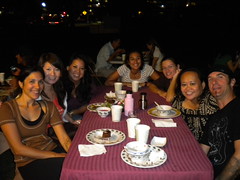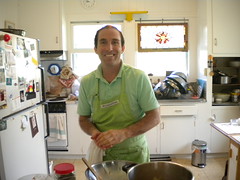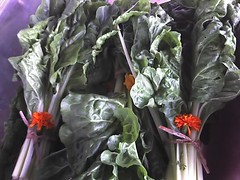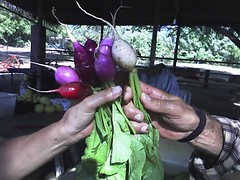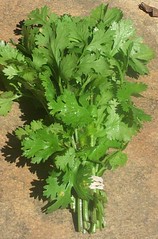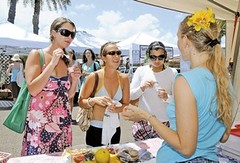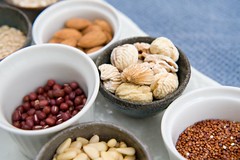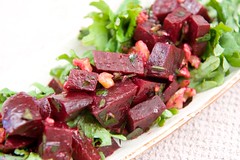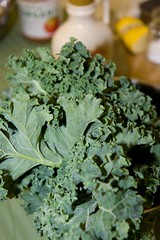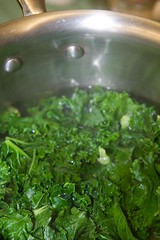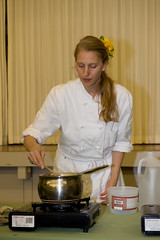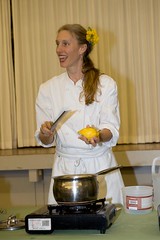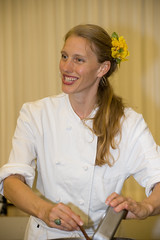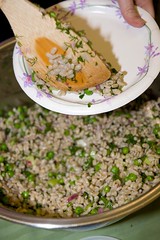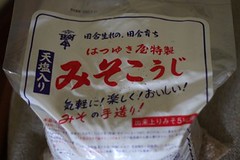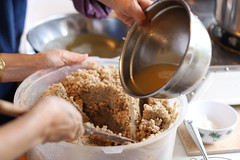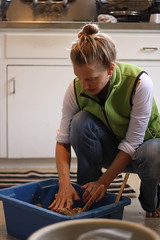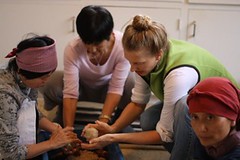Thursday, December 17, 2009
Great friends
Waiting in line for the final Macro Dinner
Wednesday, November 25, 2009
>> 12 TIPS FOR STAYING HEALTHY FOR THE HOLIDAYS <<
gatherings.
2. Stop eating when you are 80% full. There are always plenty of
leftovers during the holidays. You'll probably get a chance to taste
it again.
3. Fill your plate with smaller portions of each dish. Overeating is
one of the culprits of holiday sluggishness and extra holiday pounds.
4. CHEW each bite 20-25 times or more (no matter what you eat). This
can keep you from overeating and give you more time to enjoy mealtimes
with friends and family. It also leaves you more satisfied with what
you eat.
5. Eat a healthy meal before going to holiday parties, and take a
healthy dessert with you. It makes all that decadent (and fattening)
holiday food easier to resist.
6. If you eat snacks at parties, SIT DOWN to eat your food. Our bodies
process and digest food better when we are sitting down.
7. Use rice syrup, barley malt, maple syrup or agave nectar to replace
the sugar in your holiday desserts.
8. Set holiday GOALS for your health with a friend or family member.
It is always easier to resist temptations when you have a buddy and
someone to whom you can be accountable.
9. Take time to tell someone how much you appreciate them.
10. Holidays are usually busy and stressful. Treat yourself to a
shiatsu or healing massage to help you relax.
11. Make a list of things for which you are thankful.
12. Take time to reflect on what is really important to you in your
life. (And make sure you are spending at least some time doing these
things)
Enjoy your holidays! And remember the rule:
If you eat something that you know is not the best for you....
SAVOR and ENJOY every bite, and leave the guilt out of it.
Sunday, November 01, 2009
Rebalance Yourself After Overindulging
Eat simply for a little while: focus on a plant-based diet such as whole grains, beans and bean products, vegetables, sea vegetables, and naturally fermented pickles.
Try a macrobiotic home remedy called ume-sho-bancha.
Ume-Sho-Bancha
This tea is reputed to help relieve fatigue and obtain relief from over-consumption of sugar, fruit, or acid-forming foods and beverages.
½-1 umeboshi plum (no msg, sugar, or food coloring)
½-1 tsp traditional handmade shoyu
hot kukicha tea*
Place umeboshi in a cup and mash with a chopstick. Add shoyu. Pour in hot tea and stir well. Drink liquid and eat plum while hot.
*Kukicha is a Japanese tea made from the stems and twigs of the tea bush and can be found in your local health food store.
This remedy is very strong, so do not drink too often.
Thursday, October 22, 2009
Healthy Holiday Cooking with Slow Food Oahu
| Date: November 15, 2009 | ||
| Time: 4:00 pm | to | 6:30 pm |
Holidays can get a lot of people down. So many of us overeat and eat the wrong foods, leaving us feeling sluggish and grumpy. There’s another way to celebrate (and even meat lovers enjoy these dishes)!!
Leslie will teach everyone how to make healthy whole food dishes that keep your energy strong and your body light, while at the same time maintaining all the flavor that you love.
- Holiday Rice
- Shiitake Gravy
- Watercress, Fig, Artichoke Heart Salad
- Pumpkin Bread
To reserve your space at this special event, please RSVP by Monday, November 6 to Michelle at SFO.reservation@gmail.com . In your RSVP please include your name, member status, phone or email and the name of any nonmember guests you would like to bring. THIS EVENT IS LIMITED TO 15 PEOPLE, so please reply quickly if you know you would like to attend.
Non-members who are not guests of a member may sign up after October 19.
The cost for members is $35 and nonmembers is $40, and payment must be received by Friday, November 13.
Directions and further details will be sent to all confirmed participants the Wednesday prior to the event.
http://www.slowfoodoahu.org/
Class will be held at Baby aWEARness in the Manoa Marketplace, on the second floor above Bank of Hawaii.
Wednesday, October 21, 2009
Optimal Health and Healing Through Macrobiotics a BIG SUCCESS
The whole event was very refreshing and revitalizing for me personally. Thanks Warren!
Thursday, October 15, 2009
You probably don't experience these things, like fatigue, but if you do....
#1 FATIGUE!!
Weight Issues
Hypoglycemia
Skin Problems
Allergies
Arthritis
Osteoporosis
Headaches/Migraines
Reproductive Issues: PMS, Infertility, Menopause
Addictions
Heart Disease
High Blood Pressure
High Cholesterol
Anxiety, Fear, & Depression
Eating Disorders
Anemia
Warren is here to teach us all how we can address these naturally, using food and energetic medicine to heal ourselves. Restoring Your Natural Healing Ability is our first lecture! It's all about how to get out of the way so we can allow our bodies to heal and perform at their peak.
OPTIMAL HEALTH AND HEALING THROUGH MACROBIOTICS
Friday, October 09, 2009
Chard and Marigolds
Easter Egg Radishes
Wednesday, October 07, 2009
Warren Kramer cooking classes coming soon!
Fried Chickpea Patties
Pinto Bean Soup
Sweet Vegetable Jam on Steamed Bread
Coleslaw w/Tahini Mayo
Stirfried Portabello Mushrooms and Broccoli Rabe
Pear and Apple Pecan Crisp
Cooking for Natural Beauty:
Hato-Mugi and Bean Salad
Cucumber Soup
Light and Refreshing Pressed Salad with Citrus Dressing
Boiled Daikon w/Sweet Miso
Arame Cucumber Noodle Salad w/Shiso Leaf Dressing
Sweet and Sour Apple Kanten
Go to Leslie's main website, and head to the community calendar, to see more and to register.
OPTIMAL HEALTH AND HEALING THROUGH MACROBIOTICS
Sunday, October 04, 2009
Sunday Breakfast
Tuesday, September 29, 2009
Sacred Kitchen
The kitchen is also where I spend a lot of my time since cooking yummy vegan macrobiotic food and teaching is my job. I want the area to look beautiful and be a sacred space. When I walk into the kitchen, there are items that evoke positive feelings for me such as peace, abundance, and beauty. For example, we have milagros from Peru, Chinese good luck coins and characters, bowls filled with organic produce, organic teas, and symbols of longevity, prosperity, and welcome.
Sacred Kitchen 2
Offerings
Sunday, September 27, 2009
Italian Parsley
Thursday, September 24, 2009
Cooking for the Changing Seasons
Although it's still quite warm, we can start introducing a little bit of fall cooking to ease our bodies into slightly cooler weather.
Fall Cooking Style (From Aveline Kushi's Complete Guide to Macrobiotic Cooking)
During the late summer, energy begins to flow downward until it becomes very condensed by late autumn. The change from hot to cool weather is often sudden. To mitigate this change, we can begin to adjust our diet in late summer by including more early fall squashes and root vegetables in our meals. In autumn, food is more plentiful than at other seasons. Just as the trees produce a multitude of yellows, golds, oranges, reds, browns, and light greens, these beautiful colors are found in the cornucopia of grains, beans, squashes, root vegetables, and autumn greens, such as kale, turnip greens, daikon tops, and cabbages. Many of the foods harvested in the fall have natural preservative qualities and can be stored for several months to be used through the cold winter and into the spring. Millet and round vegetables, such as onions, turnips, cabbages, and squashes, may be served more frequently in the late autumn months. During the summer months, the kidneys and bladder are often overworked because of an excess intake of liquids, fruits, raw foods, and salty snack items in an attempt to balance the extreme heat. In autumn, the results of this imbalance are experienced in colds, coughs, and other sicknesses of adjustment. Stronger cooking in autumn, as well as the change in weather, starts to discharge this excess. At this season, we can begin to introduce more rich tastes and styles of cooking into our menus, such as bean stews, fried or deep fried foods, creamy grain stews, sweet rice and mochi, hot amasake, and pureed squash soup and squash pies. Dishes can be prepared with longer cooking times and styles, such as long, slow nishime-style boiling, long time sautéing, or kinpira style braising. Vegetables may be cut in larger slices and chunks for longer, more slowly cooked dishes. Sea vegetable dishes can become hardier and include tempeh, dried tofu, or soybeans. In autumn, foods may start to be seasoned with a little more sea salt and a little more oil. The amount of raw foods served can be substantially reduced and dried or cooked fruits used more in preparing desserts.
Senior Macrobiotic Teacher and Counselor Coming to Honolulu
How I would have loved to hear them all in English.
This is why I am so thrilled Warren is coming.
I first met him in Vermont, when I was working as a Cooking Class Volunteer, and again two more consecutive years after that as the Cooking Class Coordinator.
I have to say, he's brilliant. Every time I hear him lecture, I learn so much.
It's so exciting that he'll be here!!
Wednesday, September 02, 2009
Body Scrub
This procedure reminds me of the body scrub recommended in macrobiotics which is an equally wonderful way of achieving the same results: clear, soft, radiant, smooth, youthful skin; better circulation; and removal of toxins from the body.
How do you do it?
Get a large bowl or a bucket of hot water, as hot as you can tolerate, and dunk a washcloth into it. Squeeze out the excess water, and scrub your body from head to toe. When the washcloth cools down, put it back in the water and repeat squeezing it out and rubbing your body. A good body scrub takes about 15-20 minutes and should make your skin a little bit pink.
When you do this daily (or twice daily), it helps to move any stagnated energy through your body.
A body scrub in the morning will help wake you up and energize you for the day, and one in the evening will help you relax and fall asleep more easily.
Easy Lentil Soup Recipe
Lentil Soup
1/2 cup lentils (green or French)
1 onion, diced
1 carrot, diced
1 stalk celery, diced
1/2 cup organic corn
1/2 cup winter squash, kabocha or butternut, diced
1/4 cup burdock root (optional, for a smoky flavor)
1 to 2 tsp thyme
miso or sea salt, to taste
4 to 6 cups water
bay leaf, optional
Rinse the lentils and place in a pot with the water and bay leaf. Bring to a boil and cook for about 20 minutes. Meanwhile, cut all the vegetables. Add them to the lentils along with the thyme. Cook for an additional 15 to 20 minutes, or until the vegetables are soft. Season with sea salt or miso to taste.
Warren Kramer coming to Honolulu

October 13, 2009 to October 18, 2009
“Optimal Health and Healing Through Macrobiotics”
With senior macrobiotic educator and health counselor Warren Kramer, an internationally renowned senior macrobiotic educator and health counselor.
Enjoy a variety of ways to participate, including:
Cooking Classes- Cooking for Hearty Appetites, Cooking for Natural Beauty
Lectures- Restoring our Natural Healing Ability, Smart Bone Health, What do Yin and Yang Have to do with Me?
Health Consultations
What is a Consultation?
Who is Warren Kramer?
Testimonials About Warren
SIGN UP NOW! EARLY PAYMENT DISCOUNT AVAILABLE.
For schedule and prices please go to WWW.MACROBIOTICHAWAII.COM
Saturday, July 18, 2009
Mission Accomplished! Praise for Mexican Macrobiotic Community Dinner
I just want to say "Thank You" for the unbelievable Enchilada! Vegetable soup had quite a bit of happy looking veggies, the simple green salad was also super nutritious. I see many people don't realize what the real food taste like, I mean this good has to be normal? That means we're consuming too much of added chemicals, processed food everyday. The excellent ingredients you and Kathy offers for us is always extraordinary. I don't mean to exaggerate, you are just TOO GOOD.
My self-claimed food critic husband asked me for one bite looking at my enchilada, as you know, same things happened like Tofu Cheesecake incident on June 19th, remember? 2/3 of my enchilada was stolen again. His strong preconception toward Macrobiotic way of living started to change. He admits he was wrong, just wanted to eat "good food" not vegetables, weeds with sprinkles. And that good food is called Macrobiotic food, people like him exists everywhere. If they're suspicious, just bring them in to Leslie's community dinner, let them try first, then they'll know what's missing!
Thank you again. Kaori
Thursday, July 16, 2009
Love Your Liver & Gallbladder
Love Your Liver
Learn about the vital importance of your liver and how to best
nourish this amazing organ, especially in the Spring.
• Reduce fatty, fried, oily foods, including chips and baked goods.
• Eat plenty of vegetables, especially dark leafy greens.
• Use dashes of lemon juice and brown rice vinegar in foods.
• Get plenty of outdoor recreation with lots of fresh air breathing.
• Get plenty of sleep, sing and laugh often, cultivate a joy of life.
Glorify Your Gall Bladder
The Gall Bladder is known as the “Soap Dispenser” of the
body. (See illustration at right with liver on top and greenish gall bladder
nestled underneath.) Along with the liver, the gall bladder digests fats
and performs hundreds of vital functions. The American diet is, on
average, 40% fat, including harmful hydrogenated fats in
processed foods. We recommend that you avoid such fats, and
reduce saturated fats. Eating a plant-based diet and reducing the
consumption of animal foods such as meat, eggs, and dairy creates
a healthier digestive system and improves the overall function of
the liver and gall bladder. Learning the basic symptoms that can
indicate liver/gall bladder disorders can help you prevent serious
flare-ups and pain. Consult a health professional as needed.
Symptoms of Liver/Gallbladder Imbalance
• Indigestion • Eye Disorders • PMS
• Criticism • Irritability • Muscle Pain
• Anger • Gas/Bloating • Pain on right side
• Jaundice • Insomnia • Menstrual Disorders
• Nausea • Migraine Headache • Jealousy
• Fatigue • Sore “heavy” legs • Violence
Tuesday, July 14, 2009
Is the health food store "healthy"?
Saturday, July 11, 2009
Using leftovers creatively
Saturday, June 20, 2009
Ionia Macrobiotic Community Youth Conference in Alaska
Check out Ionia's website. I LOVE LOVE LOVE the photo of them harvesting and drying their own seaweed. It looks like it could be kombu.
www.ionia.org
What does your environment say about you?
I had a lot of free time on my hands and had already started macrobiotics. One weekend during the afternoon, I was doing yoga, cleaning, cooking, reading, and just hanging out in my little apartment.
When I was in my hallway, I suddenly noticed how dark it was. The other thing I noticed, from a whole new point of view, was that there were two very interesting pictures up. These were the very first things I saw each and every time I came home.
What were they? The first was an oil painting that a dear friend made for me that was very well done, framed, and given to me for my birthday. The color scheme was black, grey, and white. I was looking down in the painting, feeling very sad. The second was a famous Japanese print of workers carrying heavy loads on their backs during a tumultuous and torrential rain storm over a bridge. Is it any wonder why I felt the way I did; alone, sad, and burdened? I was shocked by this realization, and changed them out immediately. I also added more light to the hallway.
The inner and the outer worlds are mirrors of one another.
Look around your home. Look at the pictures you have on your wall. Do they represent the life you want to lead of health, happiness, healing (if you are unwell), and vibrance? Or are they instead like mine were; dark, dismal, and dreary?
Please also look at your plants and garden. When you look around, is your garden healthy or is it dying? When you look at the plants and flowers you have in all the areas of your living space, are they thriving, or are they shriveled and dried up, sickly with virus? If you find plants that are unhealthy, they represent something going on in your own life. Cleaning them up, pruning, and replanting can bring better health and well-being.
Finally, scan your home. Do you have areas of clutter? These cluttered areas represent stagnation in your body and areas of your life including items such as family, health, education, travel, love, and career.
Take a fresh look at everything around you and change what doesn't help you reach your goals!!
Accolades for Jun 19 Community Dinner
With much appreciation---Alice
It was so wonderful to see you and thank you so much for sharing your delicious and nutritious dinner available for us.The corn soup was so soothing, so natural taste. The red quinoa pilaf, seaweed salad were both all flavourful, the quality of ingredients you've chosen was so fresh, your Collard tempeh wrap had perfect harmony with Tahini garlic sauce with subtle smokiness in tempeh. *Amazing dipping sauce! I'd love to learn how to prepare.My husband refused to eat Tofu cheesecake at first, I insisted to have one bite, then as you said, should I say...you warned, he ate it all by himself so I lost my dessert! Thank you again for keeping real Macrobiotic cuisine exists in Hawaii, look forward to seeing you soon. Kaori
Never thought that food like this would interest me, but it is seriously ʻono! Malia
It is great that you have these community dinners. You provide an alternative to the few places that vegans can eat. George
Monday, June 15, 2009
Hands Turned to the Soil
The first panel had Eric Enos of Ka’ala Farms, Kukui Maunakea-Forth of MA’O Farms, William Aila Jr. of the Wai’anae Boat Harbor, and Kaiulani Odem. Their messages grounded and carried us through the day.
The main themes they spoke of focused on the importance of patience in making changes, the concept of kuleana (a Native Hawaiian word that means right, privilege, concern, responsibility), the politics of water on the island, and that for any change to happen, we have to start with ourselves and families first.
From here, I moved on to hear many great things about changes at UH during "College Campuses – Revolutionizing Food & Farming at the University of Hawai‘i by Ashley Lukens, Dept. of Political Science; Brooke Monroe, SOFT Garden; and Kalei Kawa‘a, Ka Papa Lo‘i o Kanewai". UH now has it's own organic garden in the back near the UH Federal Credit Union and Sustainable Saunders with veggies for sale to students and faculty and they need help too. To learn all about the varieties of taro/kalo, Ka Papa Lo‘i o Kanewai teaches and provides opportunities to work in the taro patch. Ashley teaches a course in the Poly Sci Dept about Food Security!
From there, I learned about healing foods from the Hawaiian point of view during La‘au Lapa‘au from Mary Correa, Instructor of La‘au Lapa‘au and HWST 107 at Kapi‘olani Community College. I'll post some stuff she said in the next blog.
Finally, I learned some cool stuff about local limu (seaweed) from Uncle Henry Chang Wo and Wally Ito of the Ewa Limu Beach Project. I'm going to post about them in a separate blog as well!
7 steps to health from Mary Correa, Instructor of La‘au Lapa‘au and HWST 107 – Kapi‘olani Community College
Towards the end of the session, we got to try some "edible weeds" and they were really tasty!! I've got my eye out for them now so I can find them growing around here and there.
One aspect of what she was presenting really caught my attention since Denny Waxman has his 7 Steps to Strengthening Health.
To maintain good health she said we should do these 7 things:
1. Pray and/or meditate daily
2. Make healthy lifestyle choices
3. Be mindful of the foods we eat
4. Exercise regularly (gently)
5. Drink water (instead of processed beverages)
6. Fast/cleanse during the change of seasons
7. Breathe
I'm so happy to know that more people are teaching about the connections between food, lifestyle changes, and health.
* Limu * Seaweed *
Henry and Wally of Ewa Beach Limu Project taught us about how they are doing aqua culture on the Leeward side of the island. It sounds like they find species of limu that grow in the ocean, and then bring them back to their farm to cultivate them. They didn't feel we could sustain ourselves on what's available in the ocean because development and environmental changes have diminished the supply.
They told us how certain varieties that were previously thought extinct, they have actually been finding and regrowing. That's so fantastic! They taught about the nutritious qualities of sea veggies, and also that they can be used in home remedies, such as a poultice on wounds.
This reminded me of how when my friend Dan cut himself while working at the farm last week, we made our own "bandaid". To do this, we took kombu, soaked it until it was soft, and taped it over the cut underneath a piece of gauze. The students at the farm were amazed to see how quickly his wound healed. Kombu power!
Honolulu Advertiser "Natural Appeal" Story
http://www.honoluluadvertiser.com/article/20090615/GREEN02/906140383/Natural%20appeal
Wednesday, June 03, 2009
It's a Party! Cooking Class
In this class, Leslie will teach a variety of “party foods” that are great for potlucks, dinner events, and other celebrations.
Come relax, have fun, and learn new and delicious ways to support your health and well-being.
Toho no Hikari, 3510 Nuuanu Pali Drive, $38
http://www.macrobiotichawaii.com/2009/05/26/its-a-party-cooking-class/
Friday, May 29, 2009
Macrobiotic Dinner, Frequently Asked Questions
http://www.macrobiotichawaii.com/chef-services/community-dinners/
Q. Do you have to be a church member to go to the dinner? Similarly, are there only church people there?
A. This dinner is completely 100% open to all. We have a wide variety of people who attend, some of whom happen to be church members, but the majority of whom are not affiliated with the church. The Church of the Crossroads has a long history of supporting a wide variety of people who are invested in peaceful, non-violent, green and sustainable living. They generously allow us use of their space.
~~~~~~~~~~~~~~~~~~~~~~~~
Q. Do you have to come at 6:00 pm?
A. You can come all the way up until 7:30! Even if you are running late, we try to be as flexible as possible by holding dinners for people until we are finished cleaning.
~~~~~~~~~~~~~~~~~~~~~~~~
Q. Is everyone there vegan and/or macrobiotic?
A. We have a wide range of customers who come from diverse backgrounds. What everyone seems to have in common is that they want to enjoy a healthy meal that aligns with their value system of eating healthy, delicious, local, organic, whole foods.
~~~~~~~~~~~~~~~~~~~~~~~~
Wednesday, May 13, 2009
Power of farming from public radio show
YOUNG: When Michelle Obama rolled up her sleeves and started digging a garden on the White House lawn, advocates for healthy local food cheered. The First Lady set a powerful example by inviting Washington, DC schoolchildren to garden along with her.
The message: the inner city, too, can have access to fresh, organic food. And in these tough times this is especially important. Government figures show that some 36 million people live in households that have trouble just putting food on the table.
Jessica Ilyse Smith tells us about efforts in New York City to bring high quality foods to struggling neighborhoods.
[SOUNDS AT A BODEGA]
SMITH: It's Saturday morning at the Cemalyn Grocery in Brooklyn. Cesar Rodriguez tends to his customers.
[SOUNDS OF RODRIGUEZ RINGING UP CUSTOMERS]
SMITH: Soda, cookies, chips and canned foods line the walls of Rodriguez's bodega. But, among the sea of processed foods and packaged goods, stands a small outpost of fresh fruits and green leafy vegetables.
[RODRIGUEZ POINTING OUT THE FRUITS AND VEGETABLES IN SPANISH]
SMITH: Rodriguez recently added these fresh foods to his store. He's one of almost 1,000 bodega owners taking part in New York City's Healthy Bodegas Initiative.
The Health Bodegas Initiative encourages families to drink low-fat milk. (Courtesy of NYC Dept. of Health & Mental Hygiene)
[RODRIGUEZ SPEAKING SPANISH]
VOICEOVER: Through the program, we're trying to improve people's health and the health of the neighborhood, have people eat healthier products, and lose weight because obesity is a sickness here in our community.
SMITH: Low-income neighborhoods like Rodriguez's have few supermarkets or other options for fresh fruits and vegetables. Yet there are many places to buy fast food, candy and alcohol.
Sabrina Baronberg of the City's Department of Health and Mental Hygiene wanted to find ways to address the many health problems like obesity, diabetes and heart disease found in poorer areas. She found that 80% of the food markets in these neighborhoods were small corner stores.
BARONBERG: These areas have many more bodegas than supermarkets and very few supermarkets in fact. That really inspired me to work to make these large environmental changes to make it easier for people to eat healthier.
SMITH: So, in 2006 Baronberg began to work with bodega owners and kicked-off the Healthy Bodegas Initiative. She saw that residents wanted to change what they ate but needed help.
BARONBERG: Nobody wants to live a life of chronic disease. So people would say to me I really want to make these changes, I want to switch to 1% milk, I want to eat more fruits and vegetables, I want to be healthier but I can't. My bodega only sells junk food and there aren't any supermarkets. So what am I supposed to do? And, you know, there is nothing more frustrating than that.
SMITH: New York City's neighborhoods are not the only areas with limited access to healthy food. These so-called food deserts are found across the country in rural and urban locations. Mark Winne has looked at food deserts for years.
Early growing season at Red Hook Community Farm.
(Photo: Jessica Ilyse Smith)
WINNE: It's relative based on how far somebody has to go to get to any kind of decent, affordable food store, and the means that they have to get there. And do they in fact have the means?
SMITH: Winne is the author of "Closing the Food Gap: Resetting the Table in the Land of Plenty." In the book, he chronicles the rise of food deserts in the 1960's, alongside the growth of the American suburb. With scores of people leaving downtown areas, inner cities were drained of wealth. Supermarket chains followed the wealthier client base and moved to the suburbs.
WINNE: They simply began to walk away from urban America. And these were communities that needed those stores more than others. They were communities that were being challenged by poverty, and challenged by some of the worst socioeconomic conditions that we've had perhaps in the 20th century.
SMITH: It wasn't just the lack of supermarkets that led to the growth of food deserts, but also the lack of public transportation to bring urban residents to suburban grocery stores. Winne says nearly 70% of the households in low-income neighborhoods do not own a car.
As an example he highlights the 8th ward of Washington D.C., which is close to the U.S. Capitol building. In this area, nearly 70,000 residents live with slim access to grocery stores.
WINNE: About 38% of those people are considered poor using U.S. poverty standards. If you look at the landscape we see almost no supermarkets and we also see another characteristic of a food desert, which is a tremendous number of fast food joints. And that's what people have to choose from for food. And as a result we see very high levels of obesity.
SMITH: Costs from obesity and related chronic diseases are increasing. According to the Centers for Disease Control and Prevention, the U.S. spends over 117 billion dollars a year on healthcare related to obesity. And in low-income neighborhoods with lots of fast food and few healthy options, the obesity rate is rising.
[SOUND OF RAKING LEAVES]
SMITH: Over in the Red Hook neighborhood of Brooklyn, Eugene rakes leaves that he'll add to one of the compost piles lining the side of an urban farm.
A poster encourages New Yorkers to eat fruits and vegetables to improve health and reduce the risk of diabetes, high-blood pressure, and heart disease. (Courtesy of NYC Dept. of Health & Mental Hygiene)
EUGENE: We have our compost beds over here that we've been processing for a long time. We have one that was built two months ago, and it's almost done but it's not all the way done. It's almost broken itself down, all of the nutrients and stuff like almost broken down and created our soil that we use.
SMITH: Eugene is one of about ten neighborhood teens who work at the Red Hook Community Farm. The farm - run by the non-profit group Added Value - was built literally from the ground up. Soil was brought in to cover an old abandoned ball field. If you look closely on the outskirts of the rows of onions, lettuce and beets you can still see home plate and the faint white lines that mark the field's boundaries.
This farm has not only increased the community's access to fresh and affordable fruits and vegetables, but also has helped change the neighborhood.
EUGENE: Before the farm I'd say it was pretty much a little badder, because there was still a lot of gang violence and stuff like that going around here. I'm just basically proud of being here and helping out and being able to bring healthy food to my neighborhood that I live in.
SMITH: Eugene and other teens plant seeds, harvest crops and sell their bounty at a farmer's market in the neighborhood. Before the farm started, residents went through a lot to get fresh food.
KATE: I took two buses or a car service to get food back to Red Hook. I mean you couldn't even get a quart of milk, or vegetables.
SMITH: Kate and many other Red Hook residents who buy their produce from the farm understand that fresh fruit and vegetables are important for their health. William Lewis is a longtime resident who didn't like what he found in the neighborhood before the farm.
LEWIS: Well, it was dull, there was nothing you could buy. Not fresh anyway – just regular stores, you know. When the farm came, I just started coming here because I know it's fresh food, and I like fresh, it's better for me—it's better for everyone as a matter of fact, you know?
SMITH: The farmer's market has become a neighborhood gathering place, and teens at the farm not only earn money and learn how to grow food, they also learn how to be stewards of their community...a community that is focusing on changing the circumstances of its health. Efforts like this inspire author Mark Winne:
WINNE: So it's the human innovation, creativity, willingness as a community in some sort of organized social way, and political way of trying to change the circumstances that they live in—and that really inspires me.
SMITH: Programs like the Added Value farm and the Healthy Bodegas Initiative operate from the ground up to improve the health of people living in food deserts. They also help to close what Winne calls the food gap that severely divides Americans.
For Living on Earth, I'm Jessica Ilyse Smith in New York City.
Related links:
- Added Value
- Healthy Bodegas Initiative
- “Closing the Food Gap” by Mark Winne
http://www.loe.org/shows/shows.htm?programID=09-P13-00019
federal funding to convert to organic gardening
Press Release
National Organic Coalition/National Sustainable Agriculture Coalition, May 5, 2009
Straight to the Source
NEW EQIP ORGANIC CONVERSION PROGRAM SIGN-UP
MAY 11- MAY 29 AT YOUR LOCAL NRCS OFFICE
Existing AND Transitioning Farmers Eligible
For Sign-Up Details go to the ATTRA Website or call 800-346-9140
see NSAC Memo with Details
see NRCS Directive Dated May 5, 2009
see State Allocation Amounts
Many of you worked hard to get the National Organic Conversion program in the 2008 Farm Bill (in the EQIP program at NRCS). USDA recently announced a 3-week sign-up period for farmers to receive conversion assistance.
Due to the short sign-up period, it is important that this notice gets out to farmers, and they beginning applying to their NRCS office as soon as possible -- please get this out to your networks!
For Immediate Release
Contact: Aimee Witteman, Ferd Hoefner
National Sustainable Agriculture Coalition
http://sustainableagriculture.net
PH: 202-547-5754
Organic and Transitional Farmers Restored to Rightful Status in EQIP
Washington, D.C. May 5, 2009 - USDA today announced a special three- week sign-up for farmers in the process of converting to organic farming to receive technical and financial assistance through the Environmental Quality Incentives Program (EQIP), a move applauded by the National Sustainable Agriculture Coalition and its grassroots member organizations across the country.
The organic conversion assistance was provided for by the 2008 Farm Bill but the plan went awry when the Bush Administration issued rules for the EQIP program just before leaving office which baffled state and local offices of USDA's Natural Resources Conservation Service (NRCS). As a result, in a majority of states organic farmers and transitioning farmers were simply not being served, in contradiction of Congress' intent in the farm bill.
"This was a was a wrong that needed righting, and with today's announcement USDA is not only setting it right, but doing so in an innovative and farmer-friendly manner," said Aimee Witteman, NSAC Executive Director. "We thank NRCS and USDA leadership for listening to the concerns of organic farmers and applaud their new initiative."
Today's announcement sets-aside $50 million out of the $1 billion EQIP program for a special three-week sign-up for farms converting to organic production, farms expanding their organic production, or existing organic farms who desire conservation support to reach even higher levels of environmental performance. The sign-up period begins Monday, May 11 and goes through Friday, May 29. Six core conservation practices (conservation crop rotation, cover cropping, integrated pest management, nutrient management, rotational grazing, and forage harvest management) are being made available to transitioning organic farmers on a nationwide basis. Each state may then also add a variety of "facilitating" conservation practices specific to the type of agriculture in their region.
"Obviously we would wish to have more than a very short three weeks to work with our farmer networks to get the word out and get farmers into local NRCS offices to sign up for this exciting new initiative," said Witteman. "We will work quickly to get the word out far and wide and our member organizations with expertise in organic agriculture will be helping farmers understand their options under the new program terms."
Organic farming has strong environmental benefits for soil and water quality, climate change mitigation, and biodiversity. In recognition of this fact, Congress retooled the EQIP program in the 2008 Farm Bill to provide a general EQIP priority for organic farming in the program overall as well as a specific EQIP subcomponent for farms converting in whole or in part to organic farming.
The new initiative addresses the special "organic conversion assistance" component of EQIP in particular. Funding under the organic conversion section of the farm bill is capped at not more than $20,000 per farm per year, and not more than $80,000 per farm in any 6-year period. Organic farmers may opt to compete in this special pool, with the tighter payment caps, or may opt instead to compete in the regular EQIP pool for which the 6-year cap is $300,000. However, under the terms of the new initiative announced today, farmers will receive higher payments, relative to conventional EQIP rates, for five of the six national core practices for organic conversion option. The higher payment rates reflect the higher management costs associated with the mandatory three-year organic transition period and the higher ongoing management costs associated with organic farming.
"We expect this program to evolve and grow over time," said Witteman. "NRCS has made a good faith effort to address the needs of organic farmers and appears to be willing to make this program even better on an iterative basis in future years. This is a very welcomed new day."
Sunday, May 10, 2009
Holy Yum!
"Curb Your Cravings"
"I've taken 6 or 7 of these classes before and this one was definitely the best!"
"I thought eating healthy meant eating brown rice for breakfast, lunch, and dinner, but you've shown me that eating well can taste good too. We're definitely going to be adding more beans and grains to our meals" (wife cheers on the side)
"I liked how you personalized the class and made it very comfortable and friendly for everyone and addressed each participant in the class and their concerns."
"Instructor is very enthusiastic and knowledgeable about the topic!"
Monday, May 04, 2009
7 reasons from the KI of Europe to study macrobiotics
1. Sustain your future
2. Secure your present
3. Reshape your health
4. Protect your immunity
5. Improve your condition
6. Expand your view of life
7. Challenge your commitment to the world
A Great Recipe for a peace-filled life in 2009
1. Take a 10 to 30 minute walk every day. And while you walk, smile. It
is the ultimate anti-depressant.
2. Sit in silence for at least 10 minutes each day. Talk to God about
what is going on in your life. Buy a lock if you have to.
3. When you wake up in the morning complete the following statement,
'My purpose is to __________ today. I am thankful for______________'
4. Eat more foods that grow on trees and plants and eat less food that
is manufactured in plants.
5. Drink green tea and plenty of water. Eat blueberries, wild
Alaskan salmon, broccoli, almonds & walnuts.
6. Try to make at least three people smile each day.
7. Don't waste your precious energy on gossip, vampires, energy, issues
of the past, negative thoughts or things you cannot control. Instead
invest your energy in the positive present moment.
8. Eat breakfast like a king, lunch like a prince and dinner like a
college kid with a maxed out charge card.
9. Life isn't fair, but it's still good.
10. Life is too short to waste time hating anyone.
11. Don't take yourself so seriously. No one else does.
12. You are not so important that you have to win every argument.
Agree to disagree.
Friday, April 24, 2009
Vegan Organic, Healthy, Sustainable Meals on Sundays!
If you want to "be green", macrobiotics is a great way to go!
Here are some reasons (from the Organic Consumer's Association) to eat more plant based food:
- Food accounts for 13% of all Greenhouse Gas emissions.
- Red meat and dairy are responsible for nearly half of all greenhouse gas emissions from food for an average U.S. household.
- Replacing red meat and dairy with chicken, fish, or eggs in your diet for one day per week reduces emissions equal to 760 miles per year of driving. (Imagine how eating more whole grains, beans, and vegetables would improve this number!!)
- Switching to vegetables one day per week cuts the equivalent of driving 1160 miles per year.
I'm using Ma'o Organic Farm produce like salad greens, kale, parsley, and basil as well as Mrs. Cheng's nigari tofu. Yum!
Thursday, April 23, 2009
Leslie's website
Monday, April 13, 2009
Ingredients
Tonight's dinner menu for a client
Marinated Hijiki and Lentils with Rosemary
Watercress, Fig, Artichoke, Fennel Salad with Balsamic Dressing
Glazed Beets and Walnuts
Baked Onions Stuffed with Natto and Vegetables
topped with a Miso Tahini Sauce
Tofu Cheesecake with Strawberry Topping
Marinated Beet Salad from tonight's dinner
Thursday, April 02, 2009
Eating Healthy on a Budget
Light and Luscious Lemon Pudding
Marinated Barley Pilaf
Greens with Mustard Shoyu Dressing
Garbanzo Bean Soup with Sweet Vegetables
Friday, March 27, 2009
Romanesque Cauliflower
Albert Einstein
I've been talking to someone I know about the differences between scientific veganism and macrobiotics. Macrobiotics is often criticized for being non-scientific, objective, unmeasurable, etc.
Here's a quick quote I found today that I think helps describe the ineffable aspects of macrobiotics:
"It would be possible to describe everything scientifically, but it would make no sense, as if you described a Beethoven symphony as a variation of wave pressure." Albert Einstein
Sustainability quote for the day
Funny quote for the day
Sunday, March 22, 2009
Spring into Green
Monday, March 16, 2009
Cooking Class: Eating Healthy on a Budget
March 19th, 2009
“Eating Healthy on a Budget”
Probably the most common perceived obstacle for changing one’s dietary habits is “It’s too expensive.” In this class, you will learn how to create quick and easy dishes that are extremely affordable, and of course, tasty too. You’ll also learn about the hidden costs of purchasing and eating food common in the Standard American Diet.Always included in cooking classes is detailed information about the ingredients including: - why they are good for us
- how to view their benefits in terms of Oriental Medicine
- where to purchase them
You take home the recipes and handouts, and taste the food.
Find out how whole foods prevent and reverse today’s lifestyle related illnesses.
How much is a lifetime of good health worth to you?
Leslie will teach recipes geared toward the spring season:
Sweet Vegetable and Garbanzo Bean Soup
Marinated Barley Pilaf
Greens with Mustard Shoyu Dressing
Light and Luscious Lemon Pudding
6:00 to 8:30 pm, Pan American MOA Foundation, 3510 Nuuanu Pali Drive, $38
Space still available!
Barley Koji
Blending Soybeans for Miso
Molding miso into balls
Thank you- Domo arigatou to the miso
Spring Cooking Style
The first leaves and buds of spring usually take several weeks to peek through the snow, unfold, and open (or if you live in Hawaii, the rain and chillier weather makes way for warm dry days again). In the same way, we can slowly modify our cooking as spring and warmer weather approaches. In addition to adding fresh greens to our meals, we can use more light cooking methods, such as short-time boiling, steaming, and quick sautéing. We may reduce the amount of salt and other seasonings slightly and fuse foods and pickles fermented for a shorter amount of time. During the long cold winter, the energy in our bodies often freezes, but as spring approaches, it begins to thaw and move upward and out. To help this process proceed smoothly, we begin using spring foods with upward energy such as wild grasses, sprouts and varieties of grain that have matured over the winter. Lightly fermented foods are also very helpful for releasing stagnated winter energy. Wild plants that grow in the neighborhood can be foraged. They give very strong energy and should be used only occasionally and in very small amounts. Wheat and barley have lighter energy than other grains and may be served relatively more frequently during this season. Condiments made with oil, miso, and scallions or chives are also especially enjoyable at this time of the year. As the weather turns warm, it is better to balance our meals with more lightly boiled vegetables and pressed or boiled salads rather than increase our consumption of fruit.
From Aveline Kushi's Complete Guide to Macrobiotic Cooking
